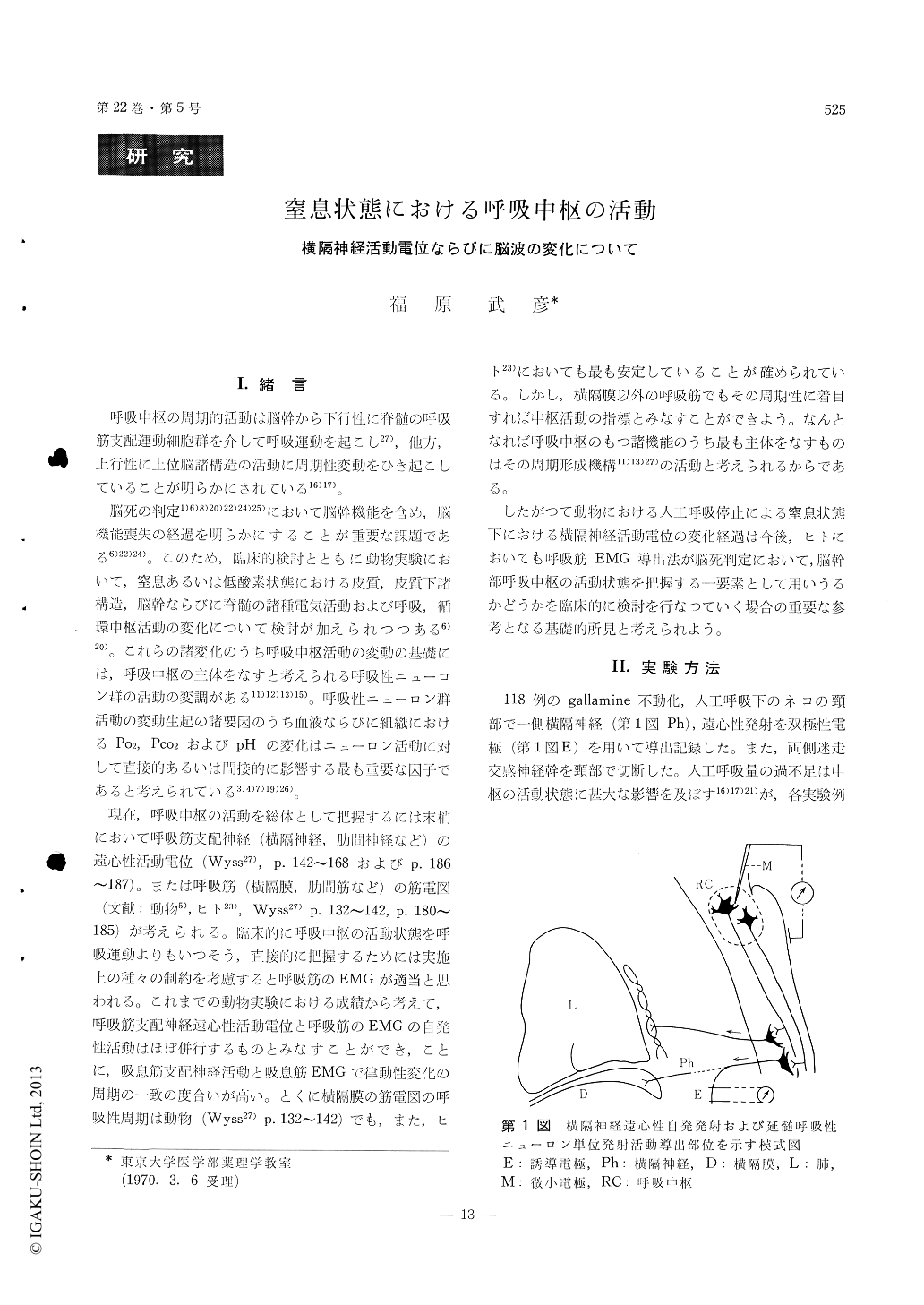Japanese
English
- 有料閲覧
- Abstract 文献概要
- 1ページ目 Look Inside
I.緒言
呼吸中枢の周期的活動は脳幹から下行性に脊髄の呼吸筋支配運動細胞群を介して呼吸運動を起こし27),他方,上行性に上位脳諸構造の活動に周期性変動をひき起こしていることが明らかにされている16)17)。
脳死の判定1)6)8)20)22)24)25)において脳幹機能を含め,脳機能喪失の経過を明らかにすることが重要な課題である6)22)24)。このため,臨床的検討とともに動物実験において,窒息あるいは低酸素状態における皮質,皮質下諸構造,脳幹ならびに脊髄の諸種電気活動および呼吸,循環中枢活動の変化について検討が加えられつつある6)20)。これらの諸変化のうち呼吸中枢活動の変動の基礎には,呼吸中枢の主体をなすと考えられる呼吸性ニューロン群の活動の変調がある11)12)13)15)。呼吸性ニューロン群活動の変動生起の諸要因のうち血液ならびに組織におけるPo2, Pco2およびpHの変化はニューロン活動に対して直接的あるいは間接的に影響する最も重要な因子であると考えられている3)4)7)19)26)。
The phrenic nerve efferent discharge and the EEGs in neocortices (motor and association area) and subcortical substrates (hippocampus, amygdala, tha-lamus, and caudate nucleus) were recorded simul-taneously in flaxedilized cats.
Alterations of the phrenic discharge, EEGs and the interrelationship between the time course of changes of the both electrical activities were analyzed during asphyxia induced by a cessation of artificial ventilation.
The eupneic pattern (E) of the phrenic discharge changed into manifold abnormal patterns within a certain elapse of time (mean, 94±4.6 sec) after cessation of ventilation. However 3 basic patterns were distinguished among various abnormal patterns. They were an apneustic (A), a gasp (G) and an intermediate pattern (A+G) in which the both pat-terns overlapped each other. These 3 patterns were discerned in sequences of changings of the phrenic discharge in each experimental case along with a elapse of time after ceasing artificial ventilation. There were found 3 series of sequences : E-G, E-A-G, and E-(A -A +G))-G in a total of 118 experimental cases. A common feature of these 3 sequences was noticed as a consistent occurence of the gasp pattern before the phrenic discharge had been abolished.
The phrenic discharge continued to exhibit the spontaneous activity revealing the 3 abnormal patterns even after the EEGs changed into a flat tracing in 81% of 118 cases. In 18% of experimental cases, however, the spontaneous activity of the phrenic discharge, neocortical and subcortical EEGs ceased simultaneously.
The time course of both electrical activities were also studied during a recovery period after a mo-mentary cessation of artificial ventilation within several minutes referring to the synchronization of the phrenic discharge with the unitary activity of bulbar inspiratory neurons.
Central mechanisms responsible for the genesis of the above mentioned abnormal patterns of the phre-nic discharge and significances of these patterns in relation to graded changes of activity of the res-piratory centers in the brainstem together with considerations on possibilities applying these findings to clinical investigations on the criteria of the death of a brain were discussed.

Copyright © 1970, Igaku-Shoin Ltd. All rights reserved.


